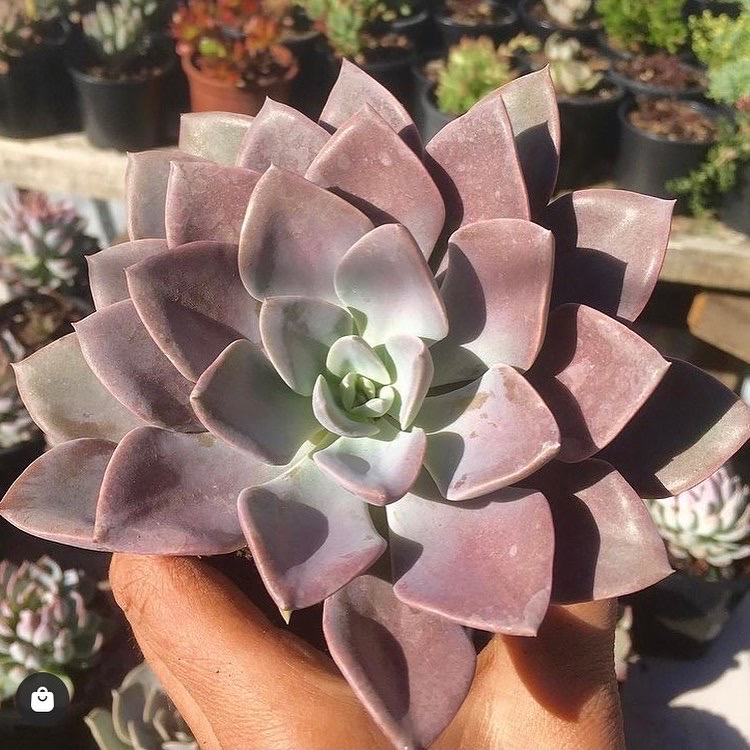Your cart is currently empty!

Graptoveria Debbi Care Tips & Propagation
Graptoveria Debbie is a fantastic hybrid that will brighten up any succulent collection. Although this succulent is very hardy there are a few tips and tricks to keeping it happy.
Below I’ll go through everything there is to know about Graptoveria Debbie. All advice is based on growing hundreds of these plants at our nursery.
Description
Graptoveria Debbi is a hybrid of Graptopetalum Amethystinum and an Echeveria species which has not been identified. The result of this cross is a gorgeous pink, rosette shaped succulent. The shades of pink change throughout the seasons.
In colder temperatures the pink almost turns purple and is very vivid but in summer it turns pale blueish-pink. The colour will also look better when Debbi is exposed to the sun and a bit stressed.
The leaves are wide and chunky. The surface is covered by a coating of farina which protects succulents against strong UV and gives the plant a dusty appearance.
Graptoveria Debbi grows on a short stalk and does not grow much taller than 10-15cm (unless it’s grown in too much shade). Individual rosettes grow to approximately 15-20cm in diameter depending on the conditions.
Offsets are quite prolific and Debbi can produce upwards of 10 per year once mature. If the offsets are left attached, they will form clumps of beautiful pink rosettes.
Graptoveria Debbi also flowers. The blooms come up on long stalks in Spring.
Position & Care
Graptoveria Debbi is a hardy plant and should be able to deal with direct sun exposure to about 35C/95F although, as with most succulents, it is recommended to either provide shelter from strong sun during heatwaves as the leaves can burn or find a spot that is shaded in the afternoon.
Morning sun/afternoon shade is the ideal position during a hot summer and full sun during the rest of the year to get that gorgeous pink.
Graptoveria Debbi is also not frost hardy and will need to be brought indoors/in a greenhouse once frosts are expected. It will, however, happily grow outdoors in low temperatures to about 1C/33F.
To get the best results, upgrade the pot once a year and plant in fresh succulent potting mix. This will ensure the Debbi will grow to its full size and have lots of offsets. If you live in a climate that often experiences hot summers avoid black pots as these will increase the heat around the root area.
Good quality succulent potting mix should result in a plant that is healthy and beautiful. Although Graptoveria Debbi is likely to grow in a generic potting mix it will not look as nice.
In the garden Debbi can be planted in a sunny spot and will be much more hardy than plants grown in pots. This means it will take higher temperatures and will not need watering as often.
Watering can be left to the rain, though do make sure to water well during heatwaves and droughts. A good rule is to water once the potting mix has dried up.
Graptoveria Debbi is not a good indoor plant as it requires direct sunlight for at least four hours per day followed by bright light. It may however do well inside with the help of professional plant growing lights.
Propagation
Graptoveria Debbi can be propagated by offsets, leaves or seeds. The easiest and fastest method of propagation is by taking cuttings of offsets/chicks.
To successfully propagate chicks it is best to wait until they are big enough and have a substantial stalk that can be cut through. The cutting should be left to dry for 24hrs and then planted in succulent potting mix.
All propagating should be done during the growing season which is Spring and Summer. In moderate climates Graptoveria Debbi will propagate in Autumn as well. My favourite time to propagate is Spring as it is not yet hot enough that the cuttings will burn and pretty much all succulents grow incredibly fast during this time. In summer during hot days cuttings can be a bit vulnerable and burn easily if exposed to strong sun.
Leaf propagation is very easy as well and a single leaf can grow more than one rosette. If the leaves are taken off in the growing season new plants will start emerging after about 2-3 weeks.
Seed propagation can be quite unreliable and extremely slow and thus I would not recommend going down this path given leaf and offset propagation is so easy.
Pests
Graptoveria Debbi is susceptible to all the usual succulent pests such as mealy bugs, aphids and snails/slugs. Mealy bugs are quite a danger and Debbi happens to be one of their favourite plants.
We have a full article on mealy bugs and how to deal with them here.
For a full list of pests and how to treat them see our article on animals that like to eat succulents.
Toxicity
There is limited reliable information as to the toxicity of Graptoveria Debbi. Graptopetalum and Echeveria are usually not toxic to humans, dogs, cats, livestock or other pets, but as there is no information on this particular plant, do not consume.
If it has been consumed by accident by a young child, as a precaution consult a medical professional.
Where Can I Get It?
Graptoveria Debbi is a fairly recent cultivar and so it’s unlikely you will be able to find it in the local garden centre. Specialist succulent nurseries may stock this plant. Online nurseries are more likely to have one.